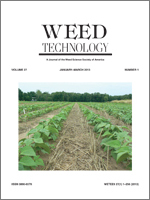Clovers are commonly included as utility plants within mixed grass swards, such as pastures and roadside right-of-ways. As such, they provide supplemental nitrogen, quality forage, and insect habitat. Yet weed control within mixed swards is often hampered by the lack of selective herbicides that are tolerated by clovers. Differential tolerance of legumes to common row-crop and pasture herbicides has previously been reported, yet little information is available that is specific to clover species. Herbicide injury of clover is often inconsistent, hypothetically due to differential species tolerance. Field and greenhouse experiments were conducted with the objective of testing differential tolerance amongst four clover species. Our experiments suggest varying tolerances amongst clover species and common broadleaf herbicides. Only imazaquin control differed due to species; however, treatment by clover interactions were further demonstrated due to variable reductions in clover height. Imazaquin, 2,4-D, 2,4-DB, and triclopyr height reductions differed due to clover species. Differential clover response to herbicide treatment should be an important consideration when managing mixed grass–clover swards and should be accounted for in future research. On a more practical level, our experiments demonstrate a range of herbicides that effectively control clover species, including atrazine, dicamba, clopyralid, 2,4-D, triclopyr, metsulfuron, and trifloxysulfuron. However, results suggest that 2,4-DB, imazethapyr, and bentazon are candidate herbicides for weed control in scenarios in which clover is a desirable crop.
Nomenclature: 2,4-D; 2,4-DB; atrazine; bentazon; clopyralid; dicamba; imazaquin; imazethapyr; MCPA; metsulfuron; triclopyr; trifloxysulfuron; ball clover, Trifolium nigrescens Viv.; crimson clover, Trifolium incarnatum L. TRFIN; small hop clover, Trifolium dubium Sibth. TRFDU; white clover, Trifolium repens L. TRFRE.
Los tréboles son comúnmente incluidos como plantas útiles dentro de zonas con coberturas mixtas de zacates, tales como pastizales y bordes de caminos. De tal forma, que brinden nitrógeno suplementario, calidad de forraje y hábitat para insectos. Sin embargo, dentro de esas zonas de cobertura mixta, el control de malezas se ve frecuentemente obstaculizado por la ausencia de herbicidas selectivos que sean tolerados por los tréboles. La tolerancia diferencial de leguminosas a herbicidas para cultivos extensivos y pasturas ha sido reportada anteriormente, aunque hay poca información disponible que sea específica para especies de trébol. El daño causado por los herbicidas es usualmente inconsistente, hipotéticamente debido a las diferencias en tolerancia entre especies. Se realizaron experimentos de campo y de invernadero con el objetivo de evaluar la tolerancia diferencial entre cuatro especies de trébol. Nuestros experimentos sugieren que existe variación entre especies de trébol en la tolerancia a herbicidas de hoja ancha comunes. Solamente el control con imazaquin difirió debido a las especies, aunque interacciones entre tratamiento y especie de trébol fueron demostradas debido a reducciones variables en la altura del trébol. Las reducciones en altura, producto del efecto de imazaquin, 2,4-D, 2,4-DB y triclopyr, variaron según la especie de trébol. La respuesta diferencial de los tréboles a los tratamientos con herbicidas debería ser una consideración importante cuando se manejan áreas con coberturas mixtas de zacates y tréboles y debería ser incluida en investigaciones futuras. A un nivel más práctico, nuestros experimentos muestran un rango de herbicidas que efectivamente controlan especies de trébol, incluyendo atrazine, dicamba, clopyralid, 2,4-D, triclopyr, metsulfuron, and trifloxysulfuron. Sin embargo, los res





